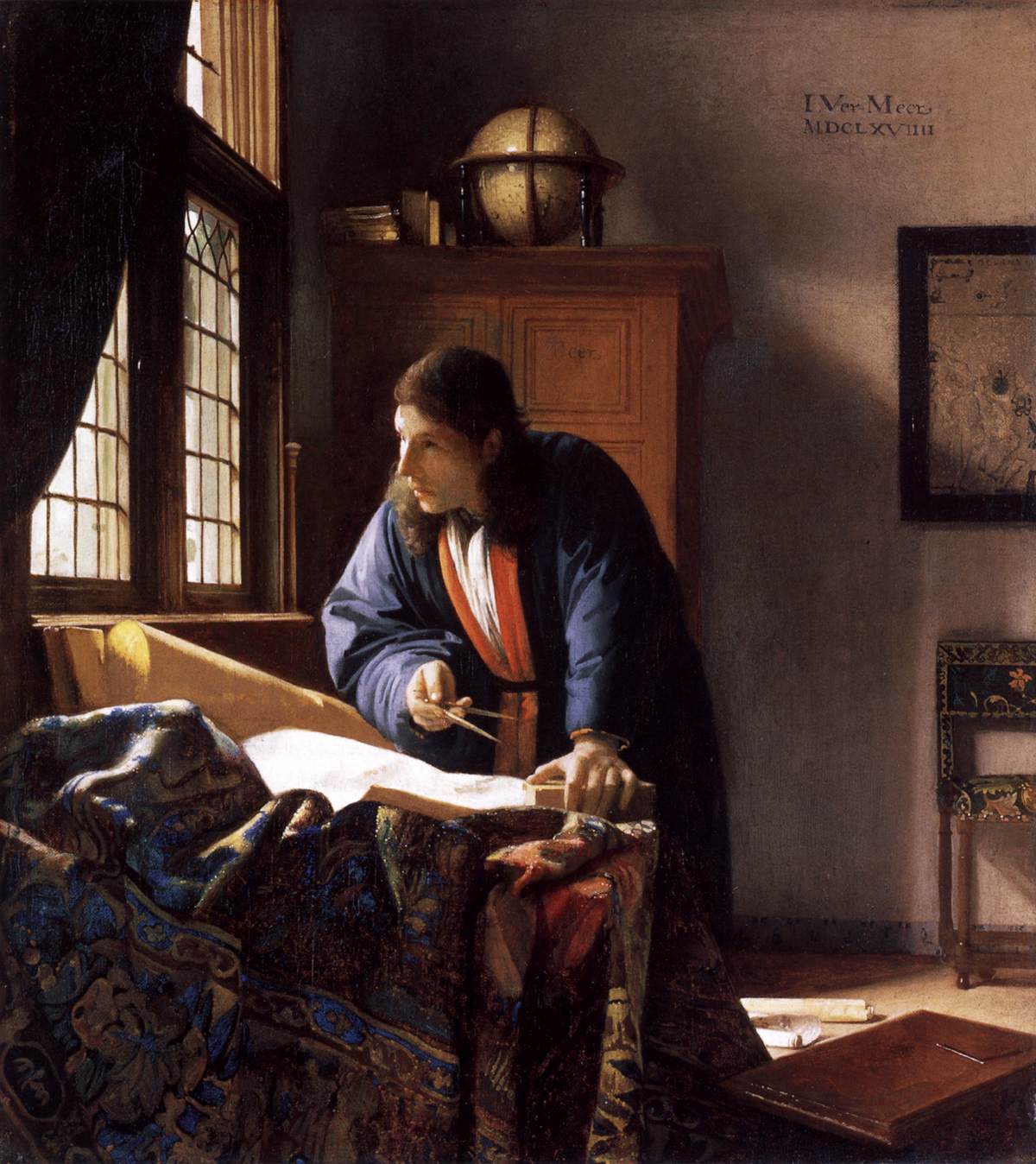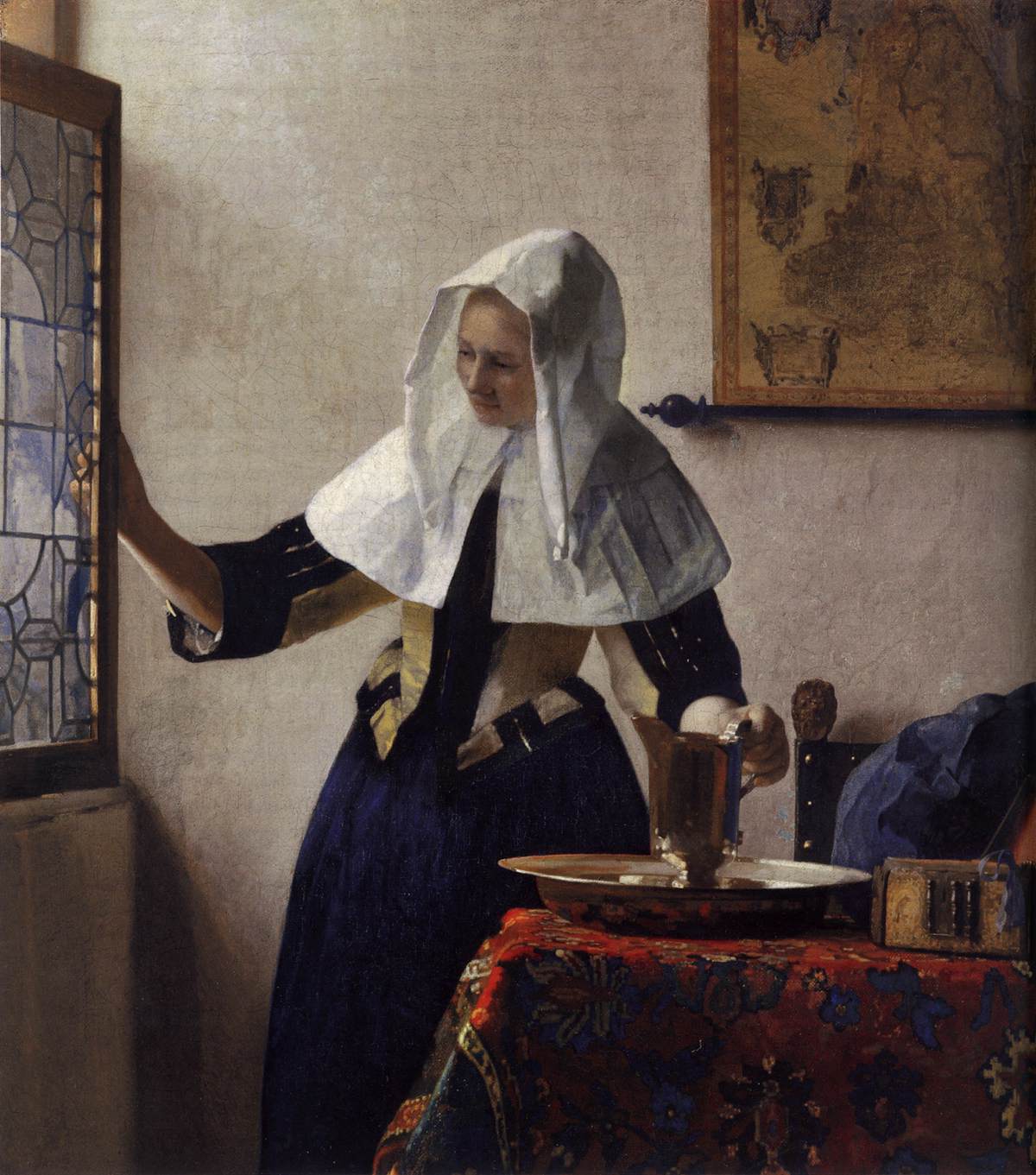.

The Geographer: Johannes Vermeer, c. 1668, oil on canvas, 53 x 46.6 cm (Städelsches Kunstinstitut, Frankfurt)
.............Let me powre forth
My teares before thy face, whil'st I stay here,
For thy face coines them, and thy stampe they beare,
And by this Mintage they are something worth,
.............For thus they bee
.............Pregnant of thee,
Fruits of much griefe they are, emblemes of more,
When a teare falls, that thou falst which it bore,
So thou and I are nothing then, when on a divers shore.
.............On a round ball
A workeman that hath copies by, can lay
An Europe, Afric, and an Asia,
And quickly make that, which was nothing, All,
.............So doth each teare,
.............Which thee doth weare,
A globe, yea world by that impression grow,
Till thy tears mixt with mine doe overflow
This world, by waters sent from thee, my heaven dissolved so.
.............O more then Moone,
Draw not up seas to drowne me in thy spheare,
Weepe me not dead, in thine arms, but forbeare
To teach the sea, what it may doe too soone,
.............Let not the winde
.............Example finde,
To doe me more harm than it purposeth,
Since thou and I sigh one anothers breath,
Who e'r sighs most, is cruellest, and hasts the others death.
John Donne: A valediction of weeping, n.d., text from Poems, 1633
Helen Gardner (The Elegies and the Songs and Sonnets of John Donne, Oxford, 1965) on ll. 10-13: The workman has copies, not originals, of maps beside him which he pastes onto a round ball to make a 'globe'. Cf.
Though the labour of any Artificer in that Trade, will bring East and West together, (for if a flat Map be but pasted upon a round Globe, the farthest East, and the Farthest West meet, and are all one) . . . (Donne to Sir Robert Carr, 1624)
David Norbrook (Introduction to The Penguin Book of Renaissance Verse 1509-1669, 1992): Donne is fond of figures drawn from the prelinguistic, deductive science of geometry. But he is more an 'anti-metaphysical' than a 'metaphysical' poet. His poems constantly explore the difficulties of relationship by means of the difficulties of representation. The cartographer's geometry has a totally different logic in two and three dimensions, the lovers' convex tears mirror each other but must acknowledge failure.
...his cartographical conceits can also indicate the delicacy and vulnerability of a mutual relationship, the mapped globe quivering with the surface tension of a tear. The greater complexity of some of the lyrics in comparison with the "Elegies' is often ascribed to Donne's marriage with Ann More, which lost him his employer's favour, so that the marriage relationship had to bear much of the weight of his earlier aspirations to the public world. Donne's marriage, at least in its early years, may indeed have had a crucial effect; Ann was descended from Sir Thomas More, and repeated puns on 'More' in the lyrics connect his love with utopian exploration.

The Geographer (detail): Johannes Vermeer, c. 1668 (Städelsches Kunstinstitut, Frankfurt)

The Art of Painting (detail): Johannes Vermeer, 1665-67 (Kunsthistorisches Museum, Viennna)

Officer with a Laughing Girl: Johannes Vermeer, c. 1657, oil on canvas, 50.5 x 46 cm (Frick Collection, New York)

Woman with a Lute near a Window (detail): Johannes Vermeer, c. 1663 (Metropolitan Museum of Art, New York)

Young Woman with a Water Jug: Johannes Vermeer, 1660-62, oil on canvas, 45.7 x 40.6 cm (Metropolitan Museum of Art, New York)

The Love Letter: Johannes Vermeer, 1667-68, oil on canvas, 44 x 38.5 cm (Rijksmuseum, Amsterdam)





8 comments:
Tear as globe. Beautiful raindrop exchange.
"We have non-stop spring rain".
How do we navigate The Zone, Tom, bearing the “fruits of much griefe?” You’ve sailed us into a tropic lush with answers, some ways of contending with even the accidental and the inevitable: window light, books, other people, “the magic-fire of music,” (as Nietzsche called it); the hands of the geographer and of the astronomer taking the measure of things, a woman with eyes closed, another smiling, all travellers like ourselves, all making the journey together, yet alone.
Much to ponder here in Donne and that school of painting in which I find many parallels with the photos of Russell Lee.
The reckless and hasty decision to run off with Ann More, the underage ward of a man on whom his career hopes, as a young law school graduate sans other prospects, depended, set Donne on an all-for-love course he would then faithfully if perhaps also desperately sail through to the end.
Ann provided him a "mast of children", and died, barely past thirty, exhausted by that childbearing and by their impoverished life.
Yet the poems he wrote to and for her in their early days together are a classic locus of the value-generating, meaning-generating exchanges, "beautiful raindrop exchanges" of two people for whom separation represents the loss of everything.
Here the speaker's pregnant tears seem a feminizing image, displacing the image of sexual aggression to be found elsewhere in early Donne poems.
"The development of thought follows the changing identities suggested for the tears -- coins, fruits, seas, mirrors, globes. By means of the conceit, the poem projects instability." -- John Carey
Donne's departures and leavetakings seem to have been the occasion of a doubled anxiety, as his experiences at sea had not been happy.
"Fruits of much griefe they are, emblemes of more"
This shift between the "fruits" and the "emblemes" intrigues me.
Is it love tipping sorrow to excess?
Are we moving from use to exchange value?
Is this about a grief observed?
That instability that Carey refers to; the terrible, ineluctable risk that love is: no simple resolutions; no fixed descriptors.
The hurt that's nothing if not communicable, seen, till it's almost livid with signifiance.
Donne was The Guv'nor, weren't he?
WB I think he has abandoned the stable world to make her his medium of exchange.
It's the famous instability of his, so many have disapproved over the centuries.
The deep hurt perhaps from the orginal sources -- who can say what it would have been like to have, as a child, watched members of your family having body parts excised before being burnt or hung as a public spectacle.
Yes, it does seem there is here a figurative category shift, back and forth between exchange and use, in fact these abrupt and willful naughty category shifts of Donne's seem to be a kind of signature with him.
The figure of the coins, stamped and given value by her, reminds us, though, in harder practical terms, that it took not only clever rhetorical shifts but coin to get, or more importantly stay, anywhere in that world (as of course also in this present one).
The mapping of the extended dominions of these great imperial maritime companies, East India, and Dutch East India, upon the walls of those interiors of Vermeer's put me in mind of the way in Donne's early Elegies the woman's body is charted out as a sort of expeditionary site.
But now in the love poems to and for Ann there is perhaps a tonal shift in among the category shifts, to something more equable -- minting these infinite (it must have seemed to him at the time) emblemes of More.
"The tears are fruits of much grief; but they are symbols of more to come. For, as your image perishes in each tear that falls, so shall we perish in each tear that falls, be nothing when between us rolls the salt, estranging sea..." (H. C. Grierson)
"While Donne was a thinking mind, vividly alert to the implications of intellectual change and controversy, he was also a receptor, played through by the divided mind of the period... for Donne the 'self' was in doubt. The more he looked at or for it, the more it vanished. Existing aso a process in time and subject to contingency and interpretation, it was possible to say 'that now / We are not just these persons, which we were' ("Womans constancy", ll. 4-4); 'You are both fluid, chang'd since yesterday' ('the second Anniversarie', l. 393")... 'Our selves', he wrote, are 'what we know not'..." -- Stevie Davies
om,
Yes, the rain here of yesterday plus full moon coupled with Donne's "teares" and "O more then moone," plus all these Vermeers -- very nice.
6.4
light coming into fog against invisible
ridge, bird slanting toward pine branch
in foreground, sound of wave in channel
arrives at “something,” same
“self” as well as one
in comparison with whom one,
sleeping, was sitting
silver line of sun reflected in channel,
cloudless blue sky to the left of point
Post a Comment